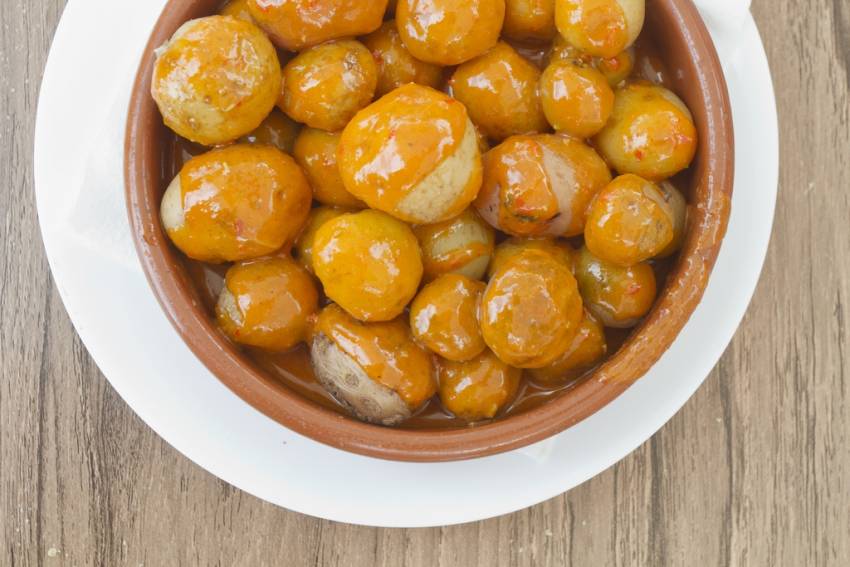Canarian food is one of the highlights of a holiday in Gran Canaria. Try it in local restaurants in the capital Las Palmas or in the hill towns. The Canary Islands dishes served in the resorts are rarely any good.
Papas Arrugadas
The Canarian dish that everybody tries and most people love. Papas arrugadas or wrinkly potatoes are small potatoes boiled their skin in sea water until the wrinkle up and develop a thin crust of salt. They are served covered with Mojo Picon, a spicy sauce made of olive oil, cumin,chili peppers, raw garlic and vinegar. The Canarian word of potato is papa, which also means pope. Some mistranslated English menus describe papas arrugadas as “wrinkly popes”!
Gofio
The staple diet of the pre-Hispanic indigenous Canarians, who did not survive the Spanish colonisation of the island, gofio is a nutritious flour made from pre-roasted barley or maize. Add it to coffee for a stomach-lining breakfast or try gofio escaldado, a sort of thick porridge flavoured with mint and eaten with raw red onions. Gofio is an acquired taste!
Sancocho Canario
A festival dish that is served on Sundays and at local Romerias (Canarian fiestas), Sancocho is a stew made from salted cod fish and sweet potato. Sancocho is traditionally served with pella de gofio, a soft paste made out of roasted maize flower and water. Sancocho is various forms can be found all over South America but the Canarian version is the original.
To be perfectly honest sancocho is incredibly fishy and salty and hardly anyone who isn't Canarian likes it.
Tropical Fruit
The subtropical climate of Gran Canaria means that it is one of the only places in Europe that can grow tropical fruit. Mangos, papayas, cactus fruit (tunos), pineapples, guavas, water melons and of course bananas are all grown locally and can be found in the main shops and markets. Canarian bananas are smaller than Caribbean ones and much tastier!
Ropa Vieja
Literally translated as “old clothes”, ropa vieja is a tasty stew made from chickpeas and chicken or beef, flavoured with bay leaves. Traditionally it was made from the meat leftover after making soups. There is a local myth that ropa vieja was invented by a man so poor that he made soup out of his clothes, which turned into this delicious dish.
Potaje
A thick and tasty vegetable soup made from potatoes, corn cobs and mixed vegetables, often with lots of watercress in it. Potaje is a good option for vegetarians. Most local restaurants make a different potaje every day.
Carne de Cabra
There is nothing better than slow-cooked, fatty goat meat served in huge portions. While lots of people think goat meat has a very strong taste, the Canarian way of stewing it on the bone makes it juicy and delicious.
Pata Asada
A staple snack, pata asada is roast pork, served cold sprinkled with sea salt. Done well it is moist and addictive! Done badly, it is shoe leather!
Squid and Octopus
There aren't many crabs and lobsters around Gran Canaria but there is plenty of squid, octopus and cuttlefish and Canarian cooks do them all justice. Squid is fried in rings (calamares fritos) and soaked in lemon juice and octopus is sliced thinly and served covered in sea salt and paprika (pulpo a la Gallega). Tiny squids are deep fried and served whole (puntitas de calamar) while cuttlefish are stewed with potatoes (choco en salsa)
Deserts
Truchas de batata are similar to turnovers and are filled with sweet potato while huevos mole is thick custard flavoured with lemon peel and cinnamon. With any desert, ask if it is home made (casero) to avoid disappointment. Mazapan is dense shortcake made from almond flour that is sold in the mountain villages.Also don't miss Guarapo, a sweet, almost black syrup made only on La Gomera from palm tree sap.














